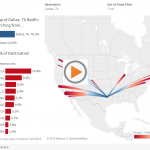A Typical African American Family Could Afford Just 25 Percent of Homes for Sale Last Year, Down from 39 Percent in 2012
Fewer than one in 10 homes for sale last year were affordable to African American households in San Francisco, Los Angeles, Seattle, Denver and Boston.
Less than 1 percent of homes for sale (just 241 out of over 54,000) in San Francisco in 2018 were affordable to African American families. The affordability crisis is the subject of The Last Black Man in San Francisco, a film that came out this year about how extreme gentrification is impacting black families with deep and rich personal histories in the city.
But it’s not just San Francisco. The share of homes affordable to African American families has declined in every major metro area since 2012, in some places by 30 percentage points or more. As of 2018, there was not a single metro area where the median African American family could afford to buy at least half of the homes for sale. Six years earlier, in 2012, there were 13 metro areas where that was true. Overall just 25 percent of homes for sale in 2018 were affordable to the median African American household, down from 39 percent in 2012.
For this report we considered all homes that were active on the market at any point in 2018 and in 2012. We calculated the share of homes in each metro area that were affordable during both years to an African American household earning the median income for their demographic in that metro area and the same for white households. Our measure of affordability assumes a 20 percent down payment, an interest rate of 4.54 percent for 2018 and 3.35 percent for 2012, and a monthly mortgage payment no more than 30 percent of gross income.
The most affordable metro areas for African American families are in the South. Memphis, Tennessee comes closest to having half the homes affordable, clocking in at 48.7 percent last year. For comparison, the median white family in Memphis could afford 80.4 percent of homes for sale last year. The next-most affordable metros for African American families were Atlanta (42.2%) and San Antonio (41.1%).
The least affordable metro areas for African American families were unsurprisingly all in California. San Jose (0.3% of homes affordable), San Francisco (0.4%), San Diego (1.2%), and Los Angeles (1.3%) made up the bottom of the list.

“As prices rise, minorities can get squeezed out of a neighborhood,” said Maryland Redfin market manager Jason Allen. “For a lot of people, homeownership is their main vehicle for building long-term wealth. Many African American families who can only afford to buy homes in communities with fewer amenities, lower-rated schools, and long commutes, end up sacrificing not only long-term appreciation, but also access to better job opportunities for themselves and better educational opportunities for their children.”
“Home prices have risen 70 percent since the beginning of the housing crash recovery in 2012,” said Redfin chief economist Daryl Fairweather. “African Americans, who were disproportionately affected by the housing crash in 2008 have found it much harder to get back into homeownership, especially as prices skyrocketed out of budget. Since there continues to be a shortage of homes at affordable price points, the future doesn’t bode well for African Americans who aspire to be homeowners without a government effort for change. The good news is that affordable housing and housing inequality is being addressed by several 2020 presidential candidates. While some candidates’ plans and proposals get more into specifics than others, the fact that it’s even being discussed on this national and at the highest level of government is a step in the right direction.”
| African American Households | White Households | |||||
|---|---|---|---|---|---|---|
| Metro Area | Percent of Listings Affordable (2018) | Percent of Listings Affordable (2012) | Percentage Point Change, 2012 to 2018 | Percent of Listings Affordable (2018) | Percent of Listings Affordable (2012) | Percentage Point Change, 2012 to 2018 |
| Memphis, TN | 48.7% | 59.9% | -11.1 | 80.4% | 88.3% | -7.9 |
| Atlanta, GA | 42.2% | 59.2% | -17.0 | 69.3% | 79.9% | -10.6 |
| San Antonio, TX | 41.1% | 62.7% | -21.7 | 62.1% | 75.1% | -13.0 |
| Columbus, OH | 40.8% | 54.0% | -13.2 | 77.7% | 83.3% | -5.6 |
| Louisville, KY | 40.1% | 44.5% | -4.5 | 70.2% | 79.0% | -8.8 |
| Indianapolis, IN | 39.6% | 56.1% | -16.5 | 78.2% | 86.4% | -8.3 |
| Detroit, MI | 39.4% | 54.7% | -15.3 | 73.4% | 84.1% | -10.6 |
| Cleveland, OH | 39.4% | 45.8% | -6.5 | 80.9% | 85.5% | -4.6 |
| Houston, TX | 39.0% | 58.0% | -19.0 | 65.7% | 79.2% | -13.4 |
| Cincinnati, OH | 37.5% | 38.8% | -1.3 | 77.5% | 85.0% | -7.6 |
| Raleigh, NC | 36.8% | 43.4% | -6.5 | 72.8% | 77.5% | -4.7 |
| Pittsburgh, PA | 36.6% | 47.1% | -10.5 | 75.5% | 78.9% | -3.4 |
| St. Louis, MO | 36.4% | 48.5% | -12.1 | 80.5% | 88.1% | -7.6 |
| Richmond, VA | 36.3% | 47.2% | -10.9 | 75.5% | 80.5% | -4.9 |
| Buffalo, NY | 36.0% | 40.3% | -4.3 | 80.4% | 88.2% | -7.7 |
| Baltimore, MD | 34.9% | 36.1% | -1.1 | 74.5% | 74.4% | 0.1 |
| Washington, D.C. | 34.8% | 37.0% | -2.2 | 68.5% | 70.6% | -2.1 |
| Charlotte, NC | 34.1% | 43.4% | -9.4 | 65.0% | 75.7% | -10.7 |
| Kansas City, MO | 33.0% | 51.4% | -18.4 | 75.4% | 85.4% | -10.0 |
| Philadelphia, PA | 32.4% | 37.3% | -4.9 | 74.1% | 78.4% | -4.4 |
| Oklahoma City, OK | 32.4% | 47.8% | -15.4 | 75.2% | 84.4% | -9.3 |
| Tampa, FL | 31.5% | 51.6% | -20.1 | 56.6% | 73.3% | -16.7 |
| Birmingham, AL | 30.7% | 44.4% | -13.7 | 70.9% | 80.0% | -9.1 |
| Dallas, TX | 30.4% | 53.4% | -23.0 | 66.0% | 77.0% | -11.0 |
| Jacksonville, FL | 28.9% | 34.8% | -5.9 | 64.9% | 69.7% | -4.8 |
| Austin, TX | 28.2% | 43.4% | -15.2 | 63.3% | 67.3% | -4.0 |
| Orlando, FL | 24.9% | 57.7% | -32.8 | 56.1% | 76.8% | -20.7 |
| Miami, FL | 23.6% | 35.6% | -12.0 | 41.2% | 51.1% | -9.9 |
| Nashville, TN | 23.3% | 46.3% | -23.0 | 51.9% | 73.9% | -22.0 |
| Phoenix, AZ | 22.9% | 50.9% | -27.9 | 57.8% | 69.0% | -11.2 |
| Chicago, IL | 22.1% | 30.8% | -8.7 | 66.8% | 69.5% | -2.7 |
| New Orleans, LA | 16.5% | 31.6% | -15.1 | 64.6% | 75.4% | -10.9 |
| Minneapolis, MN | 15.6% | 19.8% | -4.2 | 73.9% | 79.5% | -5.7 |
| Las Vegas, NV | 14.7% | 61.2% | -46.6 | 53.0% | 76.1% | -23.1 |
| Riverside, CA | 14.4% | 44.7% | -30.4 | 31.1% | 58.7% | -27.5 |
| New York, NY | 13.4% | 22.7% | -9.3 | 44.7% | 56.8% | -12.2 |
| Providence, RI | 11.7% | 27.1% | -15.5 | 56.7% | 59.0% | -2.3 |
| Boston, MA | 9.1% | 13.7% | -4.7 | 44.5% | 56.3% | -11.8 |
| Denver, CO | 8.5% | 21.9% | -13.3 | 42.2% | 62.6% | -20.5 |
| Sacramento, CA | 6.0% | 30.6% | -24.6 | 35.0% | 65.2% | -30.3 |
| Seattle, WA | 5.6% | 15.0% | -9.4 | 35.6% | 51.5% | -15.9 |
| Portland, OR | 2.0% | 11.6% | -9.6 | 34.2% | 56.4% | -22.2 |
| Los Angeles, CA | 1.3% | 9.1% | -7.8 | 12.2% | 28.1% | -15.9 |
| San Diego, CA | 1.2% | 14.2% | -13.0 | 12.8% | 28.1% | -15.3 |
| San Francisco, CA | 0.4% | 7.5% | -7.0 | 20.0% | 31.2% | -11.2 |
| San Jose, CA | 0.3% | 9.6% | -9.3 | 6.6% | 22.7% | -16.1 |
| Combined Metro | 25.3% | 38.6% | -13.3 | 57.5% | 69.1% | -11.7 |
The rate of affordability for white households has tumbled over the 2012 to 2018 period as well, but in most metro areas the declines have not been as steep. Even in metro areas where the share of listings affordable to white households has fallen more than for African American households, the rate for white households is still much higher. For example, in Cincinnati, the median white household could afford 77.5 percent of the listings in 2018, down 7.6 points from 2012. For the median African American household in Cincinnati, the decline was only 1.3 points, but they could only afford 37.5 percent of homes for sale last year—less than half as many as white families.
Baltimore posted the smallest decline in the share of homes affordable to African American families between 2012 and 2018, when 34.9 percent of homes for sale were affordable, down from 36.1 percent in 2012—a decline of just 1.15 percentage points. Baltimore was also the only metro area where the share of listings affordable for white households didn’t decrease; it went up 0.1 points to 74.5 percent in 2018.
Las Vegas saw the most dramatic decline in the share of homes that African American families could afford, down 46.6 percentage points to just 14.7 percent in 2018 from 61.2 percent in 2012. The shares of homes affordable to African Americans in Orlando, Florida and Riverside, California also fell by more than 30 percentage points.
“African American families—especially those with children—often face some hard choices and tradeoffs when it comes time to consider buying a home,” explained Allen. “If they want to find a big home that they can afford, they can end up forced to the less desirable areas. In order to help promote healthy diversity, it’s important to have a good mix of housing types (condos, townhomes, single-family) available that are affordable to a diverse group of people.”
Although incomes have been rising for African American families, those gains have been outpaced by increases in home prices (up 70 percent nationally from 2012 to 2018) and mortgage rates (up from an average of 3.66% in 2012 to 4.54% in 2018), reducing overall home affordability in every major metro area.
Methodology
Using MSA-level income data broken down by race from the US Census Bureau and 30-year fixed rate mortgage data for 2018 (4.54%) and 2012 (3.35%) from Freddie Mac, we calculated a maximum affordable mortgage payment for each metro area in 2012 and 2018. We then analyzed all home listings that were active on the market at any time during 2018 and any time during 2012, using the list price, HOA dues, property taxes, and insurance, assuming a 20 percent down payment to determine whether the mortgage payment on the home would fall under a 30 percent affordability threshold for each racial group in each metro area.
The post A Typical African American Family Could Afford Just 25 Percent of Homes for Sale Last Year, Down from 39 Percent in 2012 appeared first on Redfin Blog.




